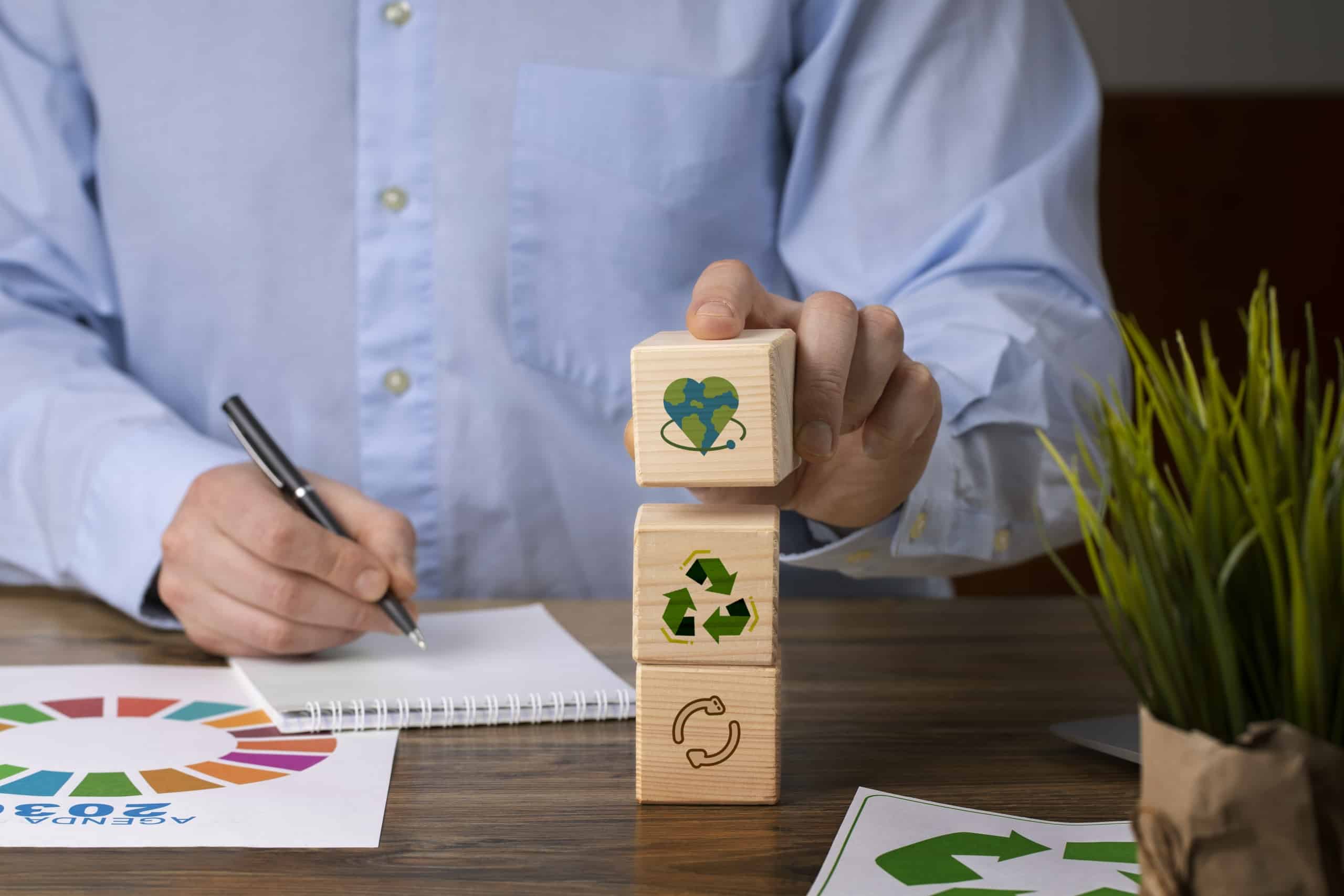Advanced Barrier Films
Advanced barrier films are a major advancement in packaging technology, especially for wet wipes. These films are carefully designed to provide a high-quality protective barrier around the goods, shielding them from many environmental conditions that might potentially harm their quality. Conventional packaging often fails to effectively block the entry of air, moisture, and impurities into the package, resulting in the desiccation or spoilage of wipes. On the other hand, sophisticated barrier films use a complex structure consisting of many layers to efficiently retain moisture and prevent the entry of undesirable substances. Every layer consists of distinct materials, each fulfilling a particular purpose, such as providing durability, adaptability, or an impermeable closure. This complex pattern guarantees that the moist towelettes maintain their freshness and efficacy for prolonged durations, therefore greatly improving their longevity on store shelves.
Furthermore, the advancement of sophisticated barrier films is not just concentrated on the preservation of products, but also on sustainability. Due to increasing environmental concerns, package producers are under mounting pressure to provide environmentally responsible solutions. Barrier films with enhanced properties are now being developed using materials that may either be recycled or naturally decompose. For example, several films use bio-based polymers that undergo natural decomposition, resulting in the absence of any detrimental residues. Some products are designed to be readily recycled, which helps to create a circular economy where resources are reused instead of being thrown away. This emphasis on both protection and sustainability is in line with the wider industry movement towards minimizing environmental harm while upholding rigorous product standards.
Advanced barrier films provide not only protection and sustainability but also practical advantages for both customers and wet wipes manufacturers. These films guarantee that the wet wipes purchased by customers are in excellent condition, providing peace of mind and enhancing the user experience. Wet wipes manufacturers may benefit from using advanced barrier films since they can help decrease product waste and returns. These films provide improved protection, reducing the chances of deterioration during transportation and storage. This may result in financial savings and enhanced brand image. With the ongoing advancement of technology, barrier films are expected to enhance their capabilities, providing increased degrees of protection and sustainability. Advanced barrier films are revolutionizing the packaging business by offering exceptional performance while also prioritizing environmental sustainability.
Modified Atmosphere Packaging (MAP)
Modified Atmosphere Packaging (MAP) is an innovative technique that is revolutionizing the way items, such as wet wipes, are packaged. It is specifically designed to increase the shelf life and maintain the quality of these products. Modified Atmosphere Packaging (MAP) works by manipulating the composition of the atmosphere inside the packaging to produce an environment that hinders the proliferation of spoiling microbes and oxidative processes. This procedure entails decreasing the quantities of oxygen while simultaneously raising the levels of nitrogen and other gases that do not readily react. Through this method, MAP efficiently retards the process of degradation, guaranteeing that the wet wipes maintain their moisture, freshness, and efficacy for an extended duration.
The advantages of MAP are many. First and foremost, it greatly prolongs the duration for which wet wipes may be stored, a critical factor for both merchants and customers. Retailers may extend the shelf life of items, so minimizing loss and maximizing sales. Consumers enjoy the guarantee that the product they buy will retain its quality over time since it increases its worth and improves customer pleasure. This is especially crucial for wet wipes that include natural components since they are more prone to oxidation and microbial proliferation. By preserving a modified environment, these natural components retain their stability and efficacy.
MAP also promotes the movement towards sustainability in packaging. This method increases the longevity of wet wipes, hence reducing the amount of wasted product and minimizing its negative effects on the environment. A decrease in the number of ruined goods results in a lower frequency of production runs and a reduction in resource consumption, spanning from raw materials to energy used in the manufacturing process. In addition, several MAP solutions are specifically engineered using recyclable components, so making a further contribution to environmentally sustainable practices. The combination of a prolonged product lifespan and a less environmental impact makes MAP a compelling choice for firms dedicated to sustainability.
One significant benefit of MAP is its capacity to be adjusted to different types of packaging. MAP may be included in various packaging formats, such as individual sachets, resealable pouches, or bulk packs, to cater to a wide range of market requirements. Wet wipes manufacturers may meet the individual tastes of consumers and retail demands by being flexible, which improves their competitiveness in the market. In addition, ongoing advancements in MAP technology are enhancing its efficiency and cost-effectiveness, therefore expanding its accessibility to a wider array of producers, including those operating in the wet wipes sector.
Implementing MAP requires the use of advanced technology and meticulous supervision of the packaging process. Contemporary MAP systems are furnished with sensors and control mechanisms that guarantee the correct gas mixes are maintained throughout the packing process. These systems are designed to optimize efficiency and dependability, hence reducing the likelihood of human mistakes and guaranteeing constant product excellence. Investing in Modified Atmosphere Packaging (MAP) technology may result in substantial benefits for wet wipes manufacturers, including improved product quality, increased consumer satisfaction, and enhanced brand loyalty.
Modified Atmosphere Packaging (MAP) is a revolutionary technique in the packaging business that provides significant advantages in terms of protecting the quality and prolonging the shelf life of wet wipes. MAP preserves the product by maintaining a regulated atmosphere within the packaging, preventing spoiling and oxidation, and improving its durability and dependability. The value of the product is further emphasized by its compatibility with sustainable practices and its ability to be used with different packaging types. As technology progresses, the functionalities of MAP will further grow, becoming an essential tool for producers striving to provide superior, durable wet wipes to the market.
Antimicrobial Packaging
Antimicrobial packaging is an advanced technology that aims to improve the longevity and safety of wet wipes. This novel method incorporates antimicrobial chemicals directly into the packing materials, effectively inhibiting the proliferation of bacteria, fungi, and other pathogens. The outcome is a substantial decrease in the likelihood of contamination, which is especially critical for wet wipes often used in personal hygiene and healthcare environments.
Antimicrobial packaging offers a significant benefit due to its proactive characteristic. Conventional packaging techniques mainly aim to provide a shield against external pollutants, but they inadequately tackle any microbes that may already exist inside the package. Antimicrobial packaging functions persistently to impede the proliferation of detrimental microorganisms, guaranteeing the product’s safety and efficacy throughout the whole duration of its storage. This is accomplished by integrating elements like silver ions, organic acids, or essential oils into the packaging material, which naturally exhibit antibacterial qualities.
Antimicrobial packaging offers an additional level of confidence for consumers. Wet wipes are often used for delicate purposes such as infant care, skin care, and medical sanitation, where cleanliness is of utmost importance. Being aware that the packaging actively decreases the amount of hazardous germs might increase customer trust and happiness. It is especially crucial in the current health-conscious industry, as customers are becoming more mindful and worried about microbial contamination.
Antimicrobial packaging provides producers with several practical advantages. Using these wipes may result in a decrease in product deterioration and waste since the wipes stay used for extended periods. Implementing this strategy not only optimizes inventory management and minimizes expenses related to product returns and disposal but also boosts the general reputation of the brand. By using antimicrobial packaging, companies may promote their goods as being more secure and dependable, therefore obtaining a competitive advantage in the market.
Furthermore, the use of antimicrobial compounds in packaging materials is becoming increasingly advanced. Advanced methodologies provide the regulated release of these compounds, ensuring their long-term efficacy without any significant contamination of the product. Ensuring a regulated release is essential for maintaining a balance between safety and efficacy, as it allows the antimicrobial qualities to be preserved over the whole life cycle of the product.
Environmental issues play a crucial role in the creation of antimicrobial packaging. Contemporary formulations aim to use substances that are both non-hazardous to human health and environmentally friendly. There is a growing interest in using biodegradable antimicrobial agents and packaging materials to reduce the environmental impact of packaging solutions. This is consistent with the wider industry movement towards sustainable and environmentally-friendly packaging alternatives.
Antimicrobial packaging is a very effective method for prolonging the shelf life and improving the safety of wet wipes. By actively suppressing microbial proliferation, it guarantees the prolonged safety and efficacy of the wipes, offering reassurance to customers and practical advantages to producers. With the ongoing progress of technology, the potential and uses of antimicrobial packaging are expected to grow, providing enhanced levels of protection and sustainability. This cutting-edge packaging solution not only meets the present market requirements for safer and more dependable goods but also paves the way for future progress in packaging technology.
Intelligent Packaging
Intelligent packaging, or smart packaging, is transforming the process of monitoring and maintaining items, such as wet wipes, during their entire lifespan. Intelligent packaging utilizes modern technology including sensors, indicators, and data carriers to offer up-to-date information on the state and quality of the product contained therein. This invention boosts customer trust, minimizes wastage, and provides an extra level of convenience that conventional packaging cannot provide.
Time-temperature indicators (TTIs) are a prominent characteristic of intelligent packaging. TTIs, also known as time-temperature indicators, are compact devices or labels that undergo a color change in response to the duration and temperature conditions experienced by the product. Temperature Time Indicators (TTIs) provide a visible indication to both customers and merchants about the freshness and safety of wet wipes, which are susceptible to changes in temperature. If the wipes have been subjected to temperatures that might potentially undermine their quality, the indication will exhibit a noticeable alteration, therefore notifying consumers of possible concerns. This proactive strategy guarantees that customers consistently have access to new and efficient goods.
Freshness sensors are an essential element of intelligent packaging. These sensors can identify variations in the surrounding conditions of the product, such as levels of moisture or the existence of certain gasses that signify decay. Freshness sensors are used in wet wipes to ensure that the moisture levels are maintained at an ideal level, preventing the wipes from either drying out or becoming too saturated. This method is especially advantageous for items containing natural components since they are more prone to spoiling. Freshness sensors ensure the quality and effectiveness of wet wipes by delivering immediate feedback throughout their storage period.
Intelligent packaging encompasses the use of RFID (Radio Frequency Identification) tags and QR codes, which provide extensive information to both customers and wet wipes manufacturers. Scanning a QR code with a smartphone allows buyers to immediately view product characteristics, use directions, and expiry dates. Such a high degree of openness improves the user experience and fosters confidence in the company. RFID tags provide producers with vital data for inventory management, allowing them to follow the product’s journey from manufacturing to the point of sale. This data has the potential to enhance supply chain optimization, minimize wastage, and enhance overall operational efficiency.
Furthermore, efficient packaging may have a pivotal impact on environmental initiatives. By supplying precise details on the product’s state, it aids in reducing superfluous waste. If consumers have dependable signs of freshness and quality, they are less inclined to discard things early. Moreover, the data obtained by intelligent packaging may assist wet wipes manufacturers in making well-informed choices about manufacturing and distribution, therefore reducing waste and optimizing resource use.
Intelligent packaging technology is facilitating individualized customer experiences. For instance, packaging may be specifically crafted to engage with applications that provide customized advice and prompts according to the consumer’s buying history and use habits. Implementing this degree of customization may bolster customer loyalty and incentivize recurring sales, as customers experience a heightened sense of affiliation with the company and its offerings.
As the technology behind intelligent packaging progresses, its uses and advantages will expand. Potential advancements may include the integration of highly advanced sensors capable of monitoring a broader spectrum of environmental variables. Additionally, packaging may be designed to establish direct communication with smart home systems, enabling customers to get timely notifications about the state of the product. These advancements will enhance the significance of packaging, transforming it from a passive vessel to an active and instructive component of the product’s overall experience.
To summarize, intelligent packaging is revolutionizing the wet wipes sector by offering up-to-date data on product freshness, bolstering customer trust, and minimizing waste. Intelligent packaging employs time-temperature indications, freshness sensors, RFID tags, and QR codes to guarantee the effectiveness and safety of wet wipes, while simultaneously promoting environmental initiatives. With the ongoing advancement of technology, intelligent packaging will increasingly play a crucial role in enhancing the customer experience by providing unparalleled levels of ease, transparency, and efficiency.
Recyclable and Compostable Packaging
Recyclable and compostable packaging is a notable advancement in the pursuit of sustainable solutions in the wet wipes business. With the growing importance of environmental issues, both consumers and manufacturers are placing more emphasis on environmentally friendly packaging solutions. Utilizing recyclable and biodegradable packaging not only decreases the negative impact on the environment but also meets the increasing customer need for eco-friendly goods.
Recyclable packaging is specifically created to undergo reprocessing and subsequent reuse, hence decreasing the need for new materials and limiting the amount of trash generated. Wet wipes often use materials like polyethylene (PE) or polyethylene terephthalate (PET) that can be readily gathered, categorized, and reused. The use of recyclable packaging is motivated by the aim to establish a circular economy, whereby resources are maintained in utilization for an extended duration. This minimizes the burden on natural resources and decreases the quantity of garbage being deposited in landfills.
Compostable packaging is specifically engineered to decompose organically into harmless substances when exposed to composting conditions. This packaging is often manufactured using bio-based materials such as cornstarch, sugarcane, or cellulose. Compostable packaging breaks down into organic matter, water, and carbon dioxide without leaving any toxic residues when placed in a composting setting. Utilizing compostable packaging for wet wipes guarantees that both the wipes and their container may biodegrade and decompose naturally, without producing any negative impact on the environment.
Recyclable and biodegradable packaging has advantages that go beyond its environmental effects. Wet wipes manufacturers may improve their brand image and attract environmentally concerned customers by using these sustainable packaging solutions. Brands that exhibit a steadfast dedication to sustainability have the opportunity to distinguish themselves in a saturated market, which may lead to increased consumer loyalty and a larger market share. Furthermore, with the tightening of rules around plastic waste, the use of recyclable and compostable packaging may assist firms in adhering to new laws and requirements.
The presence of sustainable packaging solutions also affects consumer behavior. A significant number of customers are ready to pay an additional cost for items that are packed in an environmentally conscious manner. The selection of packaging for wet wipes, often used in personal care and infant items, may have a substantial impact on consumer buying choices. Consumers are progressively seeking goods that are in line with their beliefs, and packaging that can be recycled and composted offers a concrete means for businesses to fulfill these expectations.
Technically, the development of recyclable and compostable packaging requires innovation and cooperation across the supply chain. Collaboratively, package designers and material scientists develop ecologically responsible alternatives that maintain the functionality and durability of conventional packaging. Continuous advancements in material technology are consistently enhancing the efficiency of recyclable and compostable packaging, making them more durable and appropriate for a broader array of goods.
Nevertheless, there are obstacles linked to the extensive use of recyclable and compostable packaging. The availability and quality of recycling and composting infrastructure vary greatly across different places, which may have a considerable impact on the efficiency and success of these waste management options. It is essential to educate customers on the correct techniques for of disposing recyclable and compostable packaging to maximize its intended environmental advantages. Moreover, sustainable materials can come with a higher price tag compared to traditional alternatives, which presents a financial obstacle for certain producers.
Notwithstanding these difficulties, the movement towards packaging that can be recycled and composted is gaining traction. Government entities, industry associations, and consumers are together contributing to the advancement of this transition. Efforts like extended producer responsibility (EPR) initiatives and plastic restrictions are motivating businesses to allocate resources towards sustainable packaging. As these endeavors progress, the infrastructure and technology for recycling and composting will advance, facilitating the adoption of environmentally-friendly packaging options by enterprises.
Ultimately, the use of recyclable and biodegradable packaging presents a hopeful trajectory toward achieving sustainability within the wet wipes sector. These packaging choices contribute to environmental protection and satisfy customer demand for eco-friendly goods by lowering dependence on non-renewable resources and minimizing waste. With the progress of technology and the enhancement of infrastructure, the use of recyclable and compostable packaging will become more feasible and advantageous for both wet wipes manufacturers and customers. The transition towards sustainability is not only a necessary action for the environment but also a strategic benefit in today’s market.
Vacuum Packaging
Vacuum packing is a cutting-edge and extremely efficient technique for maintaining the quality and prolonging the shelf life of wet wipes. Vacuum sealing eliminates air from the packing, creating a condition that greatly diminishes the likelihood of microbial growth and oxidation, the main culprits behind deterioration. This packing method not only preserves the moisture content and effectiveness of wet wipes but also supports ecological initiatives by minimizing waste and enhancing storage efficiency.
A key benefit of vacuum packing is its capacity to form a hermetic barrier around the wet wipes. Vacuum packing reduces the amount of oxygen, which is necessary for the development of many microbes, by removing air. This controlled atmosphere inhibits the growth and spread of germs, mold, and yeast, which may deteriorate the quality of the wipes as time passes. Wet wipes that are packed utilizing vacuum technology stay fresh and safe for a long time, which increases dependability and happiness for customers.
Vacuum packing also provides significant advantages in terms of moisture preservation. Wet wipes depend on the amount of moisture they contain to provide efficient cleaning and hygiene advantages. Nevertheless, when the wipes come into contact with air, they might lose moisture and become less efficient or completely worthless. Vacuum packing preserves the moisture inside the package, hence preserving the usage and efficacy of the wipes. It is especially crucial for wet wipes that include natural or delicate substances since they need steady conditions to maintain their quality.
Vacuum packing not only improves product preservation but also adds to sustainability via several means. This packing solution increases the longevity of wet wipes, hence reducing the occurrence of product deterioration and wastage. Consumers may use the wipes for an extended duration without concern about them desiccating or getting contaminated, resulting in a reduced number of discarded items. Furthermore, vacuum packing often necessitates a smaller amount of materials in comparison to conventional packaging techniques, leading to decreased expenses for manufacturing and shipping, as well as a diminished impact on the environment.
A further notable benefit of vacuum packing is its compactness. By eliminating air, the package becomes more streamlined and space-efficient, facilitating storage and transportation. The compactness of this product is advantageous for both merchants and customers, as it enables more effective use of storage space and decreases the environmental impact related to transportation. In addition, vacuum packing is usually lightweight, which further enhances its environmental advantages by lowering transportation weights and the resulting emissions.
From a production standpoint, the use of vacuum packing requires the use of specialized equipment that is specifically designed to effectively eliminate air and seal the packages. Contemporary vacuum packing machines exhibit tremendous efficiency since they possess the ability to handle large volumes of wet wipes with accuracy and uniformity. These devices may be incorporated into current wet wipes manufacturing lines, facilitating a smooth shift towards more sophisticated packaging options. Wet wipes manufacturers may get significant benefits in terms of product quality, customer happiness, and waste reduction by investing in vacuum packing technologies.
Nevertheless, similar to other packing methods, vacuum packaging does present certain difficulties. The initial capital outlay for vacuum packing equipment may be substantial, especially for wet wipes manufacturers of small to medium scale. Furthermore, it is crucial to ensure that the packing material has sufficient durability to maintain the vacuum seal during the whole shelf life of the product. Continuous advancements in material science are consistently enhancing the caliber and dependability of vacuum packing materials, rendering them more readily available and efficient for a diverse array of items.
Ultimately, vacuum packing serves as a potent instrument in augmenting the longevity, excellence, and eco-friendliness of wet wipes. This packing approach ensures that the wipes remain effective and free from deterioration for long durations by establishing a tightly sealed environment that retains moisture. The advantages of this extend beyond only preserving the goods, including less waste, enhanced storage efficiency, and a diminished environmental effect. With the continuous advancement of technology and materials, vacuum packing will have a growing significance in the wet wipes business. It will provide a strong and environmentally friendly option for producers and customers.
Flexible Packaging Solutions
Flexible packaging solutions are revolutionizing the wet wipes business by providing a flexible, effective, and environmentally friendly method of packaging. These solutions include a range of options, including pouches, sachets, and refill packs, all fabricated from lightweight and resilient materials. Flexible packaging is notable for its capacity to conform to various forms and sizes, making it well-suited for a diverse array of wet wipes goods. This flexibility not only improves the customer experience but also offers substantial advantages in terms of cost-effectiveness and environmental sustainability.
A prominent benefit of flexible packaging is its adaptability. Flexible packaging, unlike inflexible packaging, can quickly adapt to the shape and size of the product, enabling a more effective use of space. This is especially advantageous for wet wipes, which often come in different amounts and packing types. Flexible packaging may be customized to accommodate individual wipes, travel-sized packs, or larger numbers, offering customers a range of choices tailored to their personal needs. Wet wipes manufacturers may make use of this freedom to develop visually attractive and practical packaging that stands out on store shelves, offering design and branding possibilities.
Flexible packaging has exceptional moisture retention capabilities, making it very practical. Several flexible packaging materials are engineered with complex layered architectures that provide a robust barrier against both moisture loss and contamination. Ensuring the optimal moisture level is essential for the efficacy of wet wipes. Flexible packaging preserves the moisture of the wipes, ensuring they stay damp and ready for use, hence improving their longevity and dependability. Moreover, some adaptable packaging includes the ability to be resealed, enabling customers to preserve the freshness of the wipes even after they have been opened. This attribute is crucial for maintaining the quality of the product.
Flexible packaging options are also very efficient in terms of production and logistics. Flexible packaging manufacture often requires less amount of material and energy in comparison to conventional rigid packaging. This not only decreases the expenses of manufacturing but also lessens the impact on the environment caused by the creation of packaging. Moreover, the lightweight characteristic of flexible packaging leads to decreased transportation expenses and emissions, since a larger quantity of items may be transported in one shipment. The high level of efficiency in both manufacturing and distribution plays a significant role in advancing overall sustainability initiatives and promoting a more environmentally conscious supply chain.
The use of flexible packaging solutions is primarily motivated by the pursuit of sustainability. Several flexible packaging materials are now being designed to become recyclable and compostable. For example, some pouches and films are manufactured using bio-based polymers that are capable of being recycled or composted, therefore reducing their ecological footprint. The transition to sustainable materials is in line with the increasing customer demand for environmentally conscious goods. Wet wipes manufacturers may enhance their brand’s dedication to sustainability and attract environmentally concerned customers by opting for adaptable packaging crafted from environmentally friendly materials.
In addition, flexible packaging solutions often include useful features that improve the user experience. For instance, the inclusion of user-friendly features such as tearable apertures, resealable zippers, and integrated dispensers facilitates convenient access and use of wet wipes by customers. These features that are easy to use and understand are especially crucial for items designed for portable usage, such as travel wipes or baby wipes. Flexible packaging can enhance convenience and usefulness, which in turn may lead to increased customer pleasure and loyalty.
The advancement of flexible packaging also fosters innovation in the wet wipes business. Ongoing developments in materials science and packaging technology are continuously broadening the potential applications of flexible packaging. Wet wipes manufacturers are now able to produce packaging solutions that exceed rigorous quality and environmental criteria by using new materials that provide enhanced barrier qualities, durability, and sustainability. In addition, digital printing technology allows for the creation of high-resolution images and customized designs, providing firms with more possibilities to engage with their consumers.
To summarize, flexible packaging solutions provide several advantages for the wet wipes business. Their adaptability, effectiveness, and eco-friendliness make them an appealing choice for both wet wipes manufacturers and customers. Flexible packaging improves the total value and attractiveness of wet wipes by offering superior moisture retention, user-friendliness, and lower environmental impact. With the ongoing advancement of technology, flexible packaging will have a growing significance in the future of packaging. It will drive innovation and contribute to a more sustainable sector.








